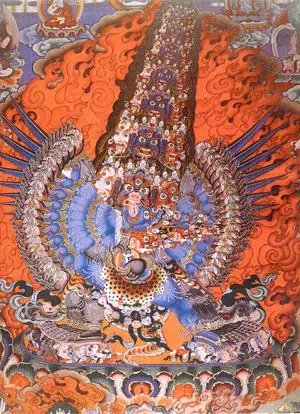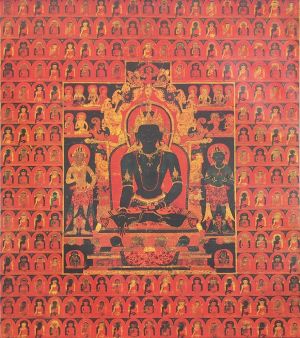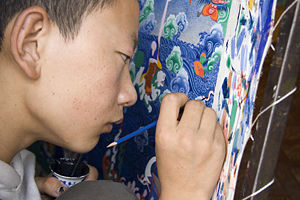Difference between revisions of "Thangka" - New World Encyclopedia
Scott Dunbar (talk | contribs) (Started) |
Scott Dunbar (talk | contribs) (Added retrieved dates) |
||
| Line 1: | Line 1: | ||
| − | {{Claimed}}{{Started}} | + | {{Images OK}}{{Claimed}}{{Started}} |
| + | [[image:Shakyamuni-Thangka.jpg|300 px|thumb|19th Century Mongolian distemper with highlights of gold, depicting [[Shakyamuni]] flanked by [[Chenrezig]] and [[Manjushri]]. The form of Manjushri depicted here, is not wielding the characteristic flaming sword, but there are many forms of the eight great[[ bodhisattvas]], some are based on the Indian tradition, and other from visions of historical masters.]] | ||
| + | |||
| + | A "'''Thangka'''," also known as "'''Tangka'''", "'''Thanka'''" or "'''Tanka'''" (Pronunciation: tänkä [the "a" as in the word "water;" the "g" is silent]) ({{bo|t=ཐང་ཀ་, [[Nepal Bhasa]]:पौभा}}) is a painted or embroidered Buddhist banner which was hung in a monastery or a family altar and occasionally carried by monks in ceremonial processions. In [[Tibetan language|Tibetan]] the word 'than' means flat and the suffix 'ka' stands for painting. The Thangka is thus a kind of painting done on flat surface but which can be rolled up when not required for display, sometimes called a scroll-painting. The most common shape of a Thangka is the upright rectangular form. | ||
| + | |||
| + | Originally, thangka painting became popular among traveling monks because the scroll paintings were easily rolled and transported from monastery to monastery. These thangka served as important teaching tools depicting the life of the Buddha, various influential lamas and other deities and [[Bodhisattva]]. One popular subject is The Wheel of Life, which is a visual representation of the Abhidharma teachings (Art of Enlightenment). | ||
| + | |||
| + | While regarded by some as colorful wall hangings, to Buddhists, these Tibetan religious paintings offer a beauty, believed to be a manifestation of the divine, and are thus visually stimulating. | ||
| + | |||
| + | Thangka, when created properly, perform several different functions. Images of deities can be used as teaching tools when depicting the life (or lives) of the Buddha, describing historical events concerning important Lamas, or retelling myths associated with other deities. Devotional images act as the centerpiece during a ritual or ceremony and are often used as mediums through which one can offer prayers or make requests. Overall, and perhaps most importantly, religious art is used as a meditation tool to help bring one further down the path to enlightenment. The Buddhist [[Vajrayana]] practitioner uses the image as a guide, by visualizing “themselves as being that deity, thereby internalizing the Buddha qualities (Lipton, Ragnubs).” | ||
| + | |||
| + | ==Types of thangkas== | ||
| + | [[Image:Tibetan Thangka, anonymous, private collection.jpg|thumb|right|300px|Tibetan [[thangka]] of the [[Hayagriva]]]] | ||
| + | [[Image:'The Dhyani Buddha Akshobhya', Tibetan thangka, late 13th century, Honolulu Academy of Arts.jpg|thumb|right|300px|'The [[Five Dhyani Buddhas|Dhyani]] Buddha [[Akshobhya]]', Tibetan [[thangka]], late 13th century, [[Honolulu Academy of Arts]]. The background consists of multiple images of the [[Five Dhyani Buddhas]].]][[Image:Painting Thangka Lhasa Tibet Luca Galuzzi 2006.jpg|thumb|right|300px|Painting Thangka in Lhasa, Tibet.]] | ||
| + | {{commons2|Thangka}} | ||
| + | Based on technique and material, thangkas can be grouped by type. Generally, they are divided into two broad categories: those which are painted (Tib.) bris-tan and those which are made of silk, either by appliqué or with embroidery. | ||
| + | |||
| + | Thangkas are further divided into these more specific categories: | ||
| + | |||
| + | * Painted in colors (Tib.) tson-tang — the most common type | ||
| + | * Appliqué (Tib.) go-tang | ||
| + | * Black Background — meaning gold line on a black background (Tib.) nagtang | ||
| + | * Blockprints — paper or cloth outlined renderings, by [[woodcut]]/[[woodblock printing]] | ||
| + | * Embroidery (Tib.) tshim-tang | ||
| + | * Gold Background — an auspicious treatment, used judiciously for peaceful, long-life deities and fully enlightened buddhas | ||
| + | * Red Background — literally gold line, but referring to gold line on a vermillion (Tib.) mar-tang | ||
| + | |||
| + | ==Support== | ||
| + | |||
| + | Thangkas are made on various fabrics. The most common is a loosely woven cotton produced in widths from 40 to 58 centimeters (16 - 23 inches). While some variations does exist, thangkas wider than 45 centimeters (17 or 18 inches) frequently have seams in the support. | ||
| + | |||
| + | ==Process== | ||
| + | |||
| + | Painted thangkas are done on cotton canvas or silk with water soluble pigments, both mineral and organic, tempered with a herb and glue solution - in Western terminology, a [[distemper (paint)|distemper]] technique. The entire process demands great mastery over the drawing and perfect understanding of iconometric principles. | ||
| + | |||
| + | The composition of a thangka, as with the majority of [[Buddhist art]], is highly geometric. Arms, legs, eyes, nostrils, ears, and various ritual implements are all laid out on a systematic grid of angles and intersecting lines. A skilled thangka artist will generally select from a variety of predesigned items to include in the composition, ranging from alms bowls and animals, to the shape, size, and angle of a figure's eyes, nose, and lips. The process seems very scientific, but often requires a very deep understanding of the symbolism of the scene being depicted, in order to capture the essence or spirit of it. | ||
| + | |||
| + | Thangka are often overflowing with symbolism and allusion. Because the art is explicitly religious all symbols and allusions must be in accordance with strict guidelines laid out in buddhist scripture. The artist must be properly trained and have sufficient religious understanding, knowledge and background in order to create an accurate and appropriate thangka. Lipton and Ragnubs clarify this in ''Treasures of Tibetan Art'': | ||
| + | |||
| + | “[Tibetan] art exemplifies the nirmanakaya, the physical body of Buddha, and also the qualities of the Buddha, perhaps in the form of a deity. Art objects, therefore, must follow rules specified in the Buddhist scriptures regarding proportions, shape, color, stance, hand positions, and attributes in order to personify correctly the Buddha or Deities.” | ||
| + | |||
| + | ==References== | ||
| + | *Lipton, Barbara and Ragnubs, Nima Dorjee. Treasures of Tibetan Art: Collections of the Jacques Marchais Museum of Tibetan Art. Oxford University Press, New York. 1996 | ||
| + | *''Art of Enlightenment: A persepective on the Sacred Art of Tibet'', Yeshe De Project. Dharma Publishing, Berkeley, CA 1987. | ||
| + | |||
| + | ==External links== | ||
| + | :''All links retrieved Dec. 5, 2007.'' | ||
| + | * [http://www.thangka.de More than 4500 pages of sacred Tibetan art from Dharmapala Thangka Centre - Kathmandu | Nepal] | ||
| + | * [http://www.dawaarts.com/inner.htm Tibetan Buddhist Thangka Paintings for Meditational and Spiritual practices - Dawa Arts] | ||
| + | * [http://www.thangkapaintings.com/thankauseimportance.php Importance and Use Of Thangka] | ||
| + | * [http://www.thebuddhahunter.com Online Gallery of Thangka Artwork from Tibet, Nepal and Himalayan India] | ||
| + | * [http://www.tibetcolor.com/tatsurphu.htm Makers of Giant Thangkas in Tibet] | ||
| + | * [http://www.tibetcolor.com/taleslieappl.htm Applique Thangkas] | ||
| + | * [http://www.pureview.co.nz A selection of hi-res downloadable thangkas | Pure View] | ||
| + | |||
| + | |||
| + | [[Category: Philosophy and religion]] | ||
| + | [[Category: Religion]] | ||
| + | |||
| + | {{Credit|175850290}} | ||
Revision as of 07:31, 5 December 2007

A "Thangka," also known as "Tangka", "Thanka" or "Tanka" (Pronunciation: tänkä [the "a" as in the word "water;" the "g" is silent]) (Tibetan: ཐང་ཀ་, Nepal Bhasa:पौभा) is a painted or embroidered Buddhist banner which was hung in a monastery or a family altar and occasionally carried by monks in ceremonial processions. In Tibetan the word 'than' means flat and the suffix 'ka' stands for painting. The Thangka is thus a kind of painting done on flat surface but which can be rolled up when not required for display, sometimes called a scroll-painting. The most common shape of a Thangka is the upright rectangular form.
Originally, thangka painting became popular among traveling monks because the scroll paintings were easily rolled and transported from monastery to monastery. These thangka served as important teaching tools depicting the life of the Buddha, various influential lamas and other deities and Bodhisattva. One popular subject is The Wheel of Life, which is a visual representation of the Abhidharma teachings (Art of Enlightenment).
While regarded by some as colorful wall hangings, to Buddhists, these Tibetan religious paintings offer a beauty, believed to be a manifestation of the divine, and are thus visually stimulating.
Thangka, when created properly, perform several different functions. Images of deities can be used as teaching tools when depicting the life (or lives) of the Buddha, describing historical events concerning important Lamas, or retelling myths associated with other deities. Devotional images act as the centerpiece during a ritual or ceremony and are often used as mediums through which one can offer prayers or make requests. Overall, and perhaps most importantly, religious art is used as a meditation tool to help bring one further down the path to enlightenment. The Buddhist Vajrayana practitioner uses the image as a guide, by visualizing “themselves as being that deity, thereby internalizing the Buddha qualities (Lipton, Ragnubs).”
Types of thangkas


Based on technique and material, thangkas can be grouped by type. Generally, they are divided into two broad categories: those which are painted (Tib.) bris-tan and those which are made of silk, either by appliqué or with embroidery.
Thangkas are further divided into these more specific categories:
- Painted in colors (Tib.) tson-tang — the most common type
- Appliqué (Tib.) go-tang
- Black Background — meaning gold line on a black background (Tib.) nagtang
- Blockprints — paper or cloth outlined renderings, by woodcut/woodblock printing
- Embroidery (Tib.) tshim-tang
- Gold Background — an auspicious treatment, used judiciously for peaceful, long-life deities and fully enlightened buddhas
- Red Background — literally gold line, but referring to gold line on a vermillion (Tib.) mar-tang
Support
Thangkas are made on various fabrics. The most common is a loosely woven cotton produced in widths from 40 to 58 centimeters (16 - 23 inches). While some variations does exist, thangkas wider than 45 centimeters (17 or 18 inches) frequently have seams in the support.
Process
Painted thangkas are done on cotton canvas or silk with water soluble pigments, both mineral and organic, tempered with a herb and glue solution - in Western terminology, a distemper technique. The entire process demands great mastery over the drawing and perfect understanding of iconometric principles.
The composition of a thangka, as with the majority of Buddhist art, is highly geometric. Arms, legs, eyes, nostrils, ears, and various ritual implements are all laid out on a systematic grid of angles and intersecting lines. A skilled thangka artist will generally select from a variety of predesigned items to include in the composition, ranging from alms bowls and animals, to the shape, size, and angle of a figure's eyes, nose, and lips. The process seems very scientific, but often requires a very deep understanding of the symbolism of the scene being depicted, in order to capture the essence or spirit of it.
Thangka are often overflowing with symbolism and allusion. Because the art is explicitly religious all symbols and allusions must be in accordance with strict guidelines laid out in buddhist scripture. The artist must be properly trained and have sufficient religious understanding, knowledge and background in order to create an accurate and appropriate thangka. Lipton and Ragnubs clarify this in Treasures of Tibetan Art:
“[Tibetan] art exemplifies the nirmanakaya, the physical body of Buddha, and also the qualities of the Buddha, perhaps in the form of a deity. Art objects, therefore, must follow rules specified in the Buddhist scriptures regarding proportions, shape, color, stance, hand positions, and attributes in order to personify correctly the Buddha or Deities.”
ReferencesISBN links support NWE through referral fees
- Lipton, Barbara and Ragnubs, Nima Dorjee. Treasures of Tibetan Art: Collections of the Jacques Marchais Museum of Tibetan Art. Oxford University Press, New York. 1996
- Art of Enlightenment: A persepective on the Sacred Art of Tibet, Yeshe De Project. Dharma Publishing, Berkeley, CA 1987.
External links
- All links retrieved Dec. 5, 2007.
- More than 4500 pages of sacred Tibetan art from Dharmapala Thangka Centre - Kathmandu | Nepal
- Tibetan Buddhist Thangka Paintings for Meditational and Spiritual practices - Dawa Arts
- Importance and Use Of Thangka
- Online Gallery of Thangka Artwork from Tibet, Nepal and Himalayan India
- Makers of Giant Thangkas in Tibet
- Applique Thangkas
- A selection of hi-res downloadable thangkas | Pure View
Credits
New World Encyclopedia writers and editors rewrote and completed the Wikipedia article in accordance with New World Encyclopedia standards. This article abides by terms of the Creative Commons CC-by-sa 3.0 License (CC-by-sa), which may be used and disseminated with proper attribution. Credit is due under the terms of this license that can reference both the New World Encyclopedia contributors and the selfless volunteer contributors of the Wikimedia Foundation. To cite this article click here for a list of acceptable citing formats.The history of earlier contributions by wikipedians is accessible to researchers here:
The history of this article since it was imported to New World Encyclopedia:
Note: Some restrictions may apply to use of individual images which are separately licensed.

